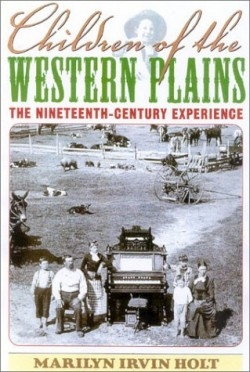Children of the Western Plains
The Nineteenth-Century Experience
Young Bertie Canfield wrote in his diary that although he thought his new home in Kansas looked “very funnie” because the landscape had no fences, he was nonetheless enthusiastic about his family’s move west from New York state: “The longer we stay the better we like it.”
In this slim volume the author fleshes out the historical topic of children growing up in the Great Plains region-Nebraska, Oklahoma, the Dakotas, and Kansas-by using the actual words of the young pioneers themselves, culled from diaries and correspondence. This nicely complements the numerous and sometimes dry statistics and data which are a required part of this kind of textbook.
Holt, the former director of publications for the Kansas State Historical Society, has written several other books dealing with historical issues and was a research consultant for the PBS American Experience series. This book is the first title in a new series called “American Childhoods.”
She has divided her subject into several general areas, such as family and community, play and leisure, and travel and settlement. She provides plenty of historical background while zeroing in on the subject at hand-how children were affected.
For example, while describing how highly desirable a strong work ethic was, she mentions the Eisenhower brothers, whose father had given them each a bit of ground on which to raise produce to sell. One, Dwight D., chose to grow sweet corn and cucumbers. “I had made inquiries (to the neighbors) and decided that these were the most popular vegetables.”
The immigrants and homesteaders were a hardy group of survivors and their children learned independence and responsibility early on. When eight-year-old Lettie Little’s mother remained weak after childbirth, she and her ten-year-old sister had to help out. “That winter we matured … dolls were laid aside.”
Strength and humor were also plentiful. Charles Driscoll, who lived on a farm, noticed while visiting the big city of Wichita, a street with red lights framing the windows and doorways labeled “Miss Emma, Miss Lucy, Miss Nellie.” Holt writes, “Charles assumed that the signs were there to help the mailman.”
Holt digs up tidbits of history and uses real-life children to help tell the story. It’s a good device; the only downside is not knowing what happened to that child later in life. Only in a couple of instances do readers learn. The enthusiastic Bertie who moved to Kansas? He died two years later of an unidentified illness.
Reviewed by
Robin Farrell Edmunds
Disclosure: This article is not an endorsement, but a review. The publisher of this book provided free copies of the book to have their book reviewed by a professional reviewer. No fee was paid by the publisher for this review. Foreword Reviews only recommends books that we love. Foreword Magazine, Inc. is disclosing this in accordance with the Federal Trade Commission’s 16 CFR, Part 255.

